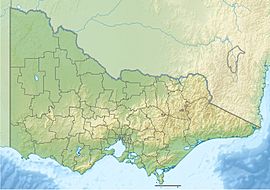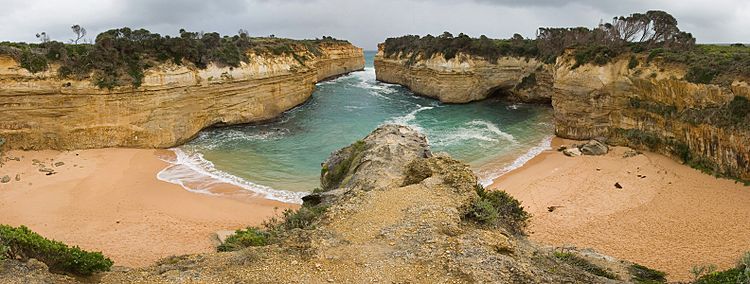Port Campbell National Park facts for kids
Quick facts for kids Port Campbell National ParkVictoria |
|
|---|---|
|
IUCN Category II (National Park)
|
|

Port Campbell National Park coastline
|
|
| Nearest town or city | Port Campbell |
| Established | 5 May 1964 |
| Area | 17.5 km2 (6.8 sq mi) |
| Visitation | circa 2,000,000 (in 1998) |
| Managing authorities | Parks Victoria |
| Website | Port Campbell National Park |
| See also | Protected areas of Victoria |
The Port Campbell National Park is a special protected area in Victoria, Australia. It is located in the south-western part of the state. This national park covers about 1,750 hectares (4,300 acres). It is found about 190 kilometers (118 miles) south-west of Melbourne and 10 kilometers (6 miles) east of Warrnambool. The park is right next to the Great Otway National Park and the Bay of Islands Coastal Park.
Discover Port Campbell National Park
Port Campbell National Park was created on May 5, 1964. It started as a smaller park, about 700 hectares (1,700 acres) in size. The main reason for creating it was to protect the amazing limestone rock formations. These formations are found along the coastline near the famous Great Ocean Road. By 1981, the park had grown to its current size of 1,750 hectares. It now stretches from Peterborough to Princetown.
Amazing Coastal Features
Port Campbell National Park is famous for its stunning coastline. You will see tall cliffs that look out over small islands and huge rock stacks. There are also deep gorges, natural arches, and blow-holes. This area is part of what is called the Shipwreck Coast. Many ships have been wrecked here over time.
Some of the most popular places to visit in the park include:
- The Twelve Apostles: These are a group of tall rock stacks standing in the ocean.
- London Arch: This was once called London Bridge because it looked like a bridge. Part of it fell down in 1990.
- Loch Ard Gorge: A beautiful gorge with a sad history of a shipwreck.
- Gibson Steps: These steps lead down to a beach where you can see the Twelve Apostles from below.
- The Grotto: A unique cave-like formation with a pool of water.
Plants and Animals of the Park
The park's cliff-tops face strong winds and salty air from the Southern Ocean. Even so, special plants manage to grow here. You can find delicate grasslands and heath-lands. These areas support beautiful flowers like sun orchid and spider orchid.
In more sheltered spots, you might see other plants. These include beard-heath, bower spinach, and coast daisy bush. There are also daisies and cushion bush. In the wilder parts of the park, you can find different types of she-oaks and dogwoods. Other plants include correa, messmate trees, trailing guinea-flower, woolly tea-tree, and scented paperbark trees.
The park is a great place for birdwatching. Many different birds live here. You can spot honeyeaters, southern emu, and fairy wrens. There are also swamp harriers, rufous bristlebirds, and powerful peregrine falcons. Along the water, you might see pelicans, ducks, black swans, and egrets.
Near the shoreline, you can find penguins, terns, and dotterels. Hooded plovers build their nests in open areas. Out at sea, you can spot Australasian gannets, wandering albatrosses, and short-tailed shearwaters. On land, the park is home to animals like the southern brown bandicoot, swamp antechinus, and echidna.



